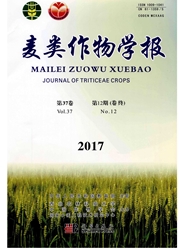

 中文摘要:
中文摘要:
二穗短柄草(Brachypodium distachyon)是一种新兴的模式植物,在病毒-植物的互作研究中具有广阔的应用前景。水稻黑条矮缩病毒(Rice black-streaked dwarf virus,RBSDV)是一种重要的植物病毒,明确该病毒是否能够侵染二穗短柄草,是进行病毒-寄主互作研究的前提。本研究利用传毒介体灰飞虱将RBSDV人工接种于二穗短柄草Bd21,观察RBSDV是否侵染短柄草,以及侵染后的症状发展过程,同时对病毒进行了PCR检测。结果显示,RBSDV可以侵染二穗短柄草;初期症状为节间缩短,随后表现植株矮缩、心叶扭曲、缺刻等症状;PCR检测有明显的目的条带。由此确定二穗短柄草是RBSDV的新寄主,可作为该病毒与寄主互作的研究材料。这为进行RBSDV抗病基因鉴定、基因组学研究以及农作物的抗病育种奠定了基础。
 英文摘要:
英文摘要:
Brachypodium distachyon is a relatively ideal model plant for gramineous plants research at present. Rice black-streaked dwarf virus(RBSDV) is one of the most important virus in China, where it causes severe yield loss. Whether RBSDV infected Brachypodium distachyon or not, is the premise to establish virus-host interaction model. An inoculation method was developed to investigate the in- fection process and symptom development. Meanwhile, RBSDV was detected with PCR in B. dis- tachyon. The results show that.B, distachyon could be infected by RBSDV. Typical symptoms such as stunting of plants, leaf distortion, small ears, outward-pointing notches could be observed in the plants. Furthermore, a clear single target band indicates that B. distachyon could be infected by RBS- DV. According to these results, B. distachyon, a new host of RBSDV, can be used as a candidate to study virus-plant interactions.
 同期刊论文项目
同期刊论文项目
 同项目期刊论文
同项目期刊论文
 期刊信息
期刊信息
